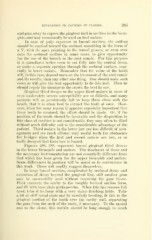Page 455 - My FlipBook
P. 455
EXCAVATION OK CAVITIES BY CLASSES. 205
and gum away to expose the gingival wall in cavities in tbe bicus-
pids, and may occasionally be used on first molars.
In case of pulp exposure in buccal cavities, tbe cutting
sbould be carried toward tbe occlusal something in tbe form of
a V, with its apex pointing to the buccal groove, or even over
onto the occlusal surface in some eases, to give opportunity
for the use of tbe broach in tbe root canals. For this purpose
it is sometimes better even to cut fully into tbe central fossa,
or make a separate opening through the occlusal surface, espe-
cially in lower molars. Remember that the value of the tooth
will, in this case, depend more on the treatment of the root canals
and its results, than any other one thing. One should make such
room as will give the best opportunity to do this well. Then be
sbould repair the damage to the crown the best he can.
Gingival third decays in the upper third molars in cases of
even moderately severe susceptibility are so difficult, and many
patients will so persistently fail to keep them clean with the
brush, that it is often best to extract tbe teeth at once. How-
ever, when for some reason it appears especially important that
these teeth ))e retained, the effort should be made. Or, if tbe
position of the tooth should be favorable and tbe disposition to
this class of cavities is not considerable, they may often be filled
without much difficulty and to the considerable advantage of the
patient. Third molars in the lower jaw are less difficult of man-
agement and are much oftener very useful teeth for abutments
for bridges when the first and second molars are lost, or so
badly decayed that their loss is feared.
Figures 288, 289, represent buccal gingival third decays
in the lower bicuspids and molars. Tbe treatment of these aud
the necessary instrumentation are not essentially different from
that which has been given for the upper bicuspids and molars.
Some differences in position will be noted as to convenience in
this work. These will readily suggest themselves.
In large buccal cavities, complicated by occlusal decay and
extension of decay beyond the gingival line, still another plan
may be successfully used without removing the gum tissue.
First excavate tbe cavity to the roughly formed outline form,
and fill with base ])late gutta-percha. When this has become full
hard, trim it to form with a very shai*p finishing knife. Take
a bit of stiff metal plate and by carefully bending, fit this to the
gingival portion of the tooth over the cavity wall, separating
the gum from tbe neck of the tooth, if necessary. To the mesial
and to tbe distal, this matrix should be long enough to reach


